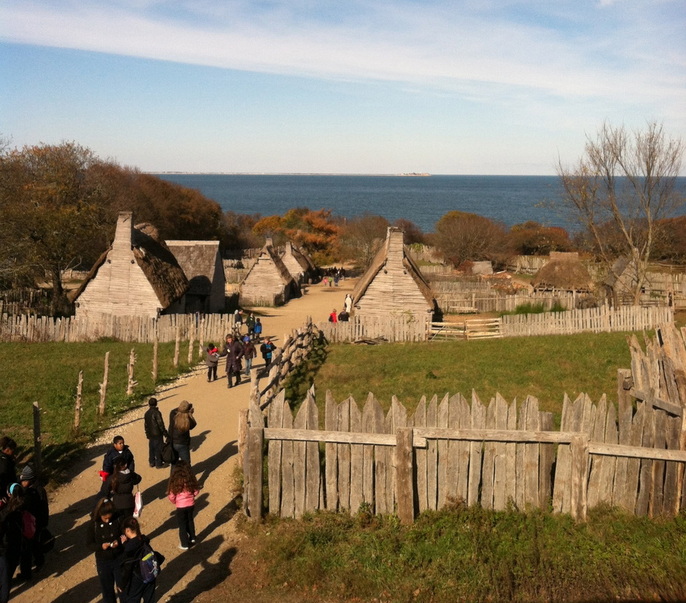In the Footsteps of the Pilgrims: Visiting Mayflower II, Plymouth Rock and the Plimoth Plantation11/5/2014 By Amy SuskiWhat better way to learn about the history of Thanksgiving than to walk in the footsteps of the Pilgrims? For families, visiting all three sites: the Mayflower II, Plymouth Rock, and Plimoth Plantation can be done in a day and is a wonderful way to bring the traditions of Thanksgiving to life. Although the original Mayflower no longer exists, a highly-accurate full-scale reproduction Mayflower II is moored in Plymouth, Massachusetts and is open to visitors. By walking the decks and exploring the quarters down below, kids will get a good idea of how cramped and difficult the 1620 journey from England must have been. Although every detail aboard the ship has been carefully reproduced, thankfully, you'll just have to imagine the pitching of the ship during a storm or the smells that the voyagers must have endured. On board you may meet costumed sailors and passengers who will be happy to share colorful tales of the perilous voyage. While visiting the Mayflower II be sure to visit Plymouth Rock, marking the site (or near abouts) of the Pilgrim's first beach landing. On several occasions the famous rock was moved and broken, but the upper half of the rock is now protected by a memorial enclosure. You can't touch the rock, but you can look at it from above. Visiting the Mayflower II and Plymouth Rock will likely take less than an hour, so most of your day should be reserved for a visit to Plimouth Plantation. Our first stop at the Plantation was the Wampanoag Homesite. Here the staff are Native American people demonstrating aspects of traditional Wampanoag life. Children may see a meal being cooked over an open fire, a mishoon boat being hollowed out from a tree, or clothing being made from deerskin. Families may even be invited into a long-house for a story or demonstration of a Wampanoag children's game. Further down the trail, families will encounter a recreation of the first community built by the Pilgrims. The 17th-Century Village brings early Plymouth to life. Costumed interpreters may show you around their kitchen gardens, demonstrate the tools they used, and introduce you to some of their heritage livestock in the Nye Barn. However, since many of the objects used by the Pilgrims in the early years were brought over from England, you will not see the Pilgrims making baskets, cookware, or other manufactured items. Instead, you can see how these items were made at the Craft Center. At the Craft Center we saw pots being made and then fired in a traditional wood-kiln. Along the way children may be asked to help grind grain or gather wood for the fire and all visitors are encouraged to ask the colonial interpreters questions. The interpreters never break character and will act very puzzled if your children ask anachronistic questions about refrigerators or TVs! After exploring the colonial dwellings and getting an idea of the daily chores required simply to stay warm and fed, our kids were amazed at the rough conditions endured by the Pilgrims and were even thankful for the boring bagged lunches we brought along. So in addition to having fun, the entire family left with a new appreciation for our blessings -- which is what Thanksgiving is all about. Even if you are unable to visit in person, the plimoth.org website offers some fun online programs for kids, including a Thanksgiving virtual field trip, coloring pages, and a "history detective" activity that explores what really happened at the famous 1621 celebration. Visitor Tips: The drive from Boston is approximately 1 hour. Mayflower II is moored at the State Pier in downtown Plymouth, about 3 miles north of Plimoth Plantation. Metered parking is available along the Plymouth waterfront and there are pay lots on Water or North Streets. At Plimoth Plantation, parking is free. The Hornblower Visitor Center offers facilities including a gift shop, cafe, and the interactive Family Discovery Station. If you prefer to bring your own food, there are outdoor picnic tables. Because most of the exhibits are outdoors, families should be prepared for some walking and dress accordingly for the weather. Some of the trails are uneven, so jogging strollers would best. For additional visitor information including tickets, hours and directions please visit www.plimoth.org. The opinions expressed are entirely my own and do not reflect those of the businesses and organizations mentioned. We did not receive any special discounts or benefits on this trip. All rights are reserved by KidTrips © 2014.
0 Comments
Leave a Reply. |
Sponsored Ads
Our BookAbout The Blog
Kid Trips' blogs profile fun events and cool family-friendly venues. We focus on regional and national family travel articles. Blogs Via Email
RSS Feed
Archives
December 2020
Links We Love |














 RSS Feed
RSS Feed


